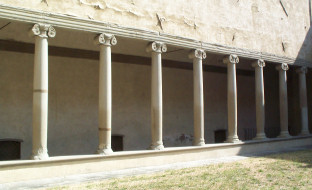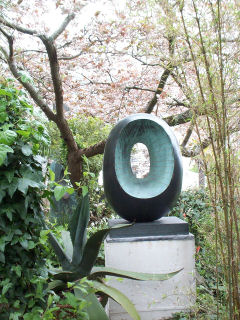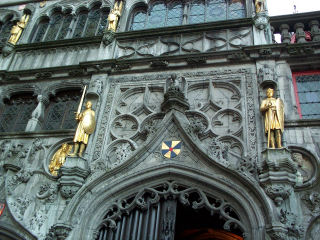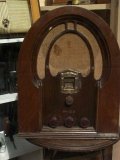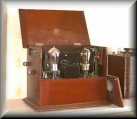Radio apparatus theory
| What is apparatus theory (from film - applied to radio)? (below on this page) |
| Apparatus theory in film (below on this page) |
| REFERENCES (below on this page) |
What is apparatus theory (from film - applied to radio)?
| I introduce apparatus theory for radio and separate it off from reception theory - for the most part. |
| Of course, there are differences between the technical aspects of the film apparatus (the camera, post-production, projector, screen, eye of spectator) and the radio apparatus (microphone, post-production, broadcasting). Then there are the similarities and differences between the social apparatuses of the audiences. |
| Framing and space (mise en scene) - the differences between the space which the camera will not see and framing in the radio drama mise en scene, which is more flexible. See SCENOGRAPHY - 'mise en scène' |
| For the radio drama listener - centering and de-centering the listener. |
| I introduce a spectrum of radio apparatuses from the 'disciplining' to the 'disappearing' |
| I suggest a new grouping of radio theory issues around the technology of broadcasting and receiving, allied to user, space, 'listening zone' and 'consummatory field' |
| apparatus of 'listening' changing so greatly that some, but not all, of the audience, and at some times, will no longer use a radio |
| digital radio can also involve the disappearance of the receiving apparatus |

|
recording systems & projector - technical, instrumental cinema - a social, psychological, and ideological apparatus Film apparatus theory of the 1970s-1980s combines two approaches: (1) the impact of the technical and physical specificity of watching films - film, lighting, sound recording systems, camera, make-up, costume, editing devices, and projector, and (2) cinema as a 'social machine'. That early film apparatus theory is now superseded. It is a reductive 'grand' theory about how all film audiences are subject to allegedly harmful psychological and ideological consequences.
See Carl Plantinga, 'Movie Pleasures and the Spectator's Experience:
Toward a Cognitive Approach' In film studies, the most visible attempt to explain spectator pleasure comes from the "apparatus theory" which dominated film theory in the 1970s and 80s. The apparatus theorists claimed to have uncovered the deep levels of spectator pleasure, which were said to originate in repressed and unconscious desires. Jean-Louis Baudry, for example, argued that mainstream films encourage a regression to primitive stages of human development, a return to a facsimile of infantile wholeness and homogeneity. Baudry and other apparatus theorists described classical cinema as a powerful, univocal fantasy machine with a specific purpose to encourage regressive psychological states that implement the subjection of the spectator to dominant ideology. The major criticisms of apparatus theory are by now well-known,
and the consensus is that it requires revision. The attraction,
and at the same time weakness, of apparatus theory was its simplicity;
it claimed to have found the essential psychological and ideological
effect of mainstream film. Positing these monolithic effects
allowed apparatus theory to take an unequivocal position on the
allegedly harmful psychological and ideological consequences
of viewing classical films. See also - Lauretis, Teresa de and Heath, Stephen, 1984, The Cinematic Apparatus, New York: St. Martin's Press
Stam, Robert, Burgoyne, Robert and Flitterman-Lewis, Sandy, 1992, New Vocabularies in Film Semiotics: Structuralism, Post-Structuralism and Beyond, London: Routledge page 22 Beginning in the mid-1970s, semiotic discussion came to be inflected by psychoanalytic notions such as scopophilia and voyeurism, and by Lacan's conception of the mirror stage, the imaginary and the symbolic. The focus of interest was no longer on the relation between filmic and image and "reality," but rather on the cinematic apparatus itself, not only in the sense of the instrumental base of camera, projector and screen, but also in the sense of the spectator as the desiring subject on which the cinematic institution depends as its object and accomplice.
Hayward, Susan, 2000, Cinema Studies: The Key Concepts, London: Routledge, pages 14-15
Branigan Chap 5 Bull, Michael, 2000, Sounding Out the City. Personal Stereos
and the Management of Everyday Life, Oxford: Berg. In disclosing the world of the auditory urban through personal-stereo use, I draw upon Appadurai's (1986) observation that material artifacts can open themselves up to many forms of investigation in pursuit of an understanding of their social meaning and identity. Traces of their possible meaning are embodied in the very practices that bring them to life. The object is not merely an artifact but also a set of practices with which an artifact is associated.
Hill, John, 1998, 'General Introduction', in Hill, John and Gibson, Pamela, The Oxford Guide to Film Studies, Oxford: Oxford University Press, 1-10.
page 3 In principle, there could be film studies based upon the science and techniques of film, its physics and chemistry, the practices and possibilities of the camera and the other apparatuses of filmmaking. Yet these have not constituted a discrete branch of film studies, nor even very often been seen as indispensable to the study of film. This is despite not only a handful of academic studies, but also the in fact rather wide-spread discourse of film science and technique in the culture at large, from the journals of professional cinematography all the way through to the lively market in special effects (how they are done) fandom. This has in part to do with the scientific illiteracy of most
of those who constructed the field. It has also to do with a
divide in conceptions of science and technology, between what
I shall call-and polarize as-objectivists and historicists. The
former see the truths of science as facts discovered in the natural
world and technical practices as things imposed upon practitioners
by apparatuses, the latter, the historicists, see scientific
knowledge constructed according to cultural paradigms and see
practices as routinized uses of apparatuses, apparatuses that
were themselves constructed according to cultural norms and could
be used differently. Kolker, Robert, 1998, 'The film text and film form' in Hill, John and Gibson, Pamela, The Oxford Guide to Film Studies, Oxford: Oxford University Press, 11-20. Eisensteinian montage and the long-take-deep-focus aesthetic
advocated by Bazin are attention-drawing forms. They foreground
cinematic structure and make them part of the narrative movement.
They are intrusive in the sense that they make the viewer aware
Vassilakis, Pantelis, 'Towards a phenomenology of film music' According to these approaches film music is assumed to be able to "fix" or "concretize" the film's indeterminate meaning, at both emotional and cognitive levels, restore a sense of unity challenged by the presumably fragmentary nature of the filmic apparatus and make aspects of time, place and narrative within a film more convincing.
Beck, Alan, 2000, 'Playing by ear: new ways of teaching and
researching radio drama', Studies in Theatre and Performance
online, December 2000, electronic publication, Radio drama is hampered, not in its digital production, but in its reproduction or broadcast - the 'kitchen radio problem'. It cannot deliver cinema's multi-channel sound from a multiplicity of perspectives around the auditorium, nor extend its frequency and dynamic range, as Sergi, 1999 evidences from film directors Lucas and Spielberg (the 'Bay Area sound'), and Scorsese and Coppola (the 'New York Metropolitan sound'), nor can it reproduce sound at virtually zero distortion (Sergi, 1998, 159). But as mentioned above, cinema's 'super-listeners' are among the demographic for radio drama.
spectrum of radio apparatuses from the 'disciplining' to the 'disappearing' Beck, Alan, 2002, The Death of Radio? An essay in radio-philosophy
for the digital age, electronic book published by Sound Journal,
Introduction 2 Section Four, 'Apparatus theory', defines this new grouping of theory issues around the technology of broadcasting and receiving, allied to user, space, 'listening zone' and 'consummatory field'. This Section also introduces a spectrum of radio apparatuses from the 'disciplining' to the 'disappearing', in an attempt to relate apparatus theory to the history of radio and, today, to the use of the multi-media computer ('disciplining') and the personal stereo / Walkman ('disappearing'). Apparatus theory is the first of my five approaches to 'What is radio?'. Beck, Alan, 2002, The Death of Radio? An essay in radio-philosophy
for the digital age, electronic book published by Sound Journal,
Some listeners will no longer use a radio? Introduction 6
Beck, Alan, 2002, The Death of Radio? An essay in radio-philosophy
for the digital age, electronic book published by Sound Journal,
Introduction 16 This monograph has five approaches to 'what is radio?' in the digital age: (1) Through technology and the radio apparatus (Section 4) Radio apparatus theory concerns itself with the technology
of both broadcasting and receiving, and with user, space, 'listening
zone' and 'consummatory field' (4.3). It is at the intersection
of a number of topics, including reception theory. Though the
definition of 'radio' (via such various communication pipelines)
must be discussed under the heading of radio apparatus theory
(or the vehicle distinction), this in itself is not a sufficient
or necessary condition (5.10).
digital radio can also involve the disappearance of the receiving apparatus Beck, Alan, 2002, The Death of Radio? An essay in radio-philosophy
for the digital age, electronic book published by Sound Journal,
Introduction 22 A second point is to do with the apparatus. Seiter also usefully makes the point: … the dual nature of communication technologies such
as television sets and computers 'as quintessentially novel objects,
and therefore as the embodiment of our desires for the new',
which simultaneously act as 'transmitters of all the images and
information that fuel those desires' (Seiter quotes from Silverstone and Hirsch, 1992, 3.) I take
up part of the 'novel' as I discuss Internet hype (1.14-15).
But digital radio can also involve the disappearance of the receiving
apparatus, as, for example, Internet radio is heard through the
computer and the conventional appearance of the radio is transformed
in the - still to come to market - DAB radio with a visual screen
for interactivity (4.5, 4.8). There is also 'hear-view' through
the TV. Beck, Alan, 2002, The Death of Radio? An essay in radio-philosophy
for the digital age, electronic book published by Sound Journal,
Apparatus Theory 4.1 Apparatus theory: the first approach This section groups some theory issues around the technology of broadcasting and receiving under my title of 'apparatus theory'. The issues are allied to user, space, 'listening zone' and 'consummatory field'. This Section also introduces a spectrum of radio apparatuses from the 'disciplining' to the 'disappearing' in an attempt to relate apparatus theory to the history of radio and, today, to the use of the multi-media computer ('disciplining') and the Walkman ('disappearing').
Reception is also called 'consumption' and 'reading' in different theoretical paradigms. De Certeau is often cited on the imperatives of reception studies and theory: … the analysis of the images broadcast by television
(representation) and of the time spent watching television (behavior)
should be complemented by a study of what the cultural consumer
"makes" or "does" during this time and with
these images. The same goes for the use of urban space, the products
purchased in the supermarket, the stories and legends distributed
by the newspapers, and so on.
I have heeded this, especially as regards the importance due to space and use. There are differing radio apparatuses involved in my typology above (3.4-5), from personal stereo to public loudspeaker, etc.
And so this brings me to the first of the five approaches promised at the top of this monograph. This is through technology and apparatus theory. I have borrowed 'apparatus theory' from film studies, where it has various, discrete uses. My application of apparatus theory to radio is confined to one coherent sector - the mechanical apparatus. It is slightly confusing that the very use of the term 'apparatus theory' could suggest reference to film psychoanalytic theory etc. I do not intend this and the note below explains these other uses. Note to 4.1
4.2 Film apparatus theory My link is to the mechanical apparatuses of filmmaking - the 'practices and possibilities of the camera and the other apparatuses of filmmaking', and the chemistry of film itself (Hill and Gibson, 1998, 3). Of course, this leads into reception theory (subject-study). Sometimes the concern is how the very presence of the camera influences the filmed events, and further on, to how the camera and film apparatus can draw attention to themselves, as in Bazin and the long-take-deep-focus aesthetic (Hill and Gibson, 1998, 17). All this is part of the materiality of the cinema, of its physicality, its corporeality, its tangibility - what Marxists call 'material culture' (Abel, 1995, 4).
Prosthesis and phenomenology 4.3 Radio apparatus theory Prosthesis and phenomenology Radio apparatus theory, as a possible future line of discussion, concerns itself with the technology of both broadcasting and receiving, and with user, space, 'listening zone' and 'consummatory field'. And, for me, it is impelled by Bull's estimable contributions in his work on the personal stereo (Bull 2001, as in 3.5 above). So the radio apparatus can be used by the listener as a 'critical tool', and for boundaries around the self as well as for sociality (Lembo 2000 on TV audiences, in 3.3). This apparatus theory is also tied to radio's and audio's conventionalised ways of representation, but these are rapidly shifting. Indeed, this monograph is a recognition of the shifting history of radio-audio perceptual psychology. This apparatus also manages space and time, and is part of constructing identity or identities (Tacchi 1998b; Tacchi, 2000, 291; Hendy, 2001, 214-24). It is also the site of fantasy and memory. The apparatus is also an extension of the human body, a prosthesis. Marshall McLuhan, in The Medium is the Massage, popularised the notion that tools are the 'extensions of man'. The wheel is an extension of the foot, the book of the eye, etc. This goes back to Merleau-Ponty and phenomenology. (Examples then were a walking stick, a hat). The boundary of the 'mind-self' and the 'body-self' begins to look 'more amorphous or at least unclear' (Forrester, 2000, 96). Sigmund Freud, in Civilisation and its Discontents, had said, referring to 'auxiliary organs': Man has, as it were, become a kind of prosthetic god. (There is a full discussion of all of this in Rybcynski, 1983, chapter 1.) The personal stereo, obviously, is a type of 'organ extension' (Rybcynski's term) of the ears, while the computer and other radio-like apparatuses augment the brain and hands. Rybcynski also argued that sometimes prostheses do not fit well, they rub us raw or itch (ib., 5). I have discussed this topic previously, suggesting that phenomenology (the presence-to-the-world and the being in a lived-in body) is another way of pondering how we sense the 'presence' of radio's performers and how, especially in stereo radio drama productions, we can enjoy an immersive experience (Beck, 2000a, 'Reception theory in the digital age'). The most recent, accessible and coherent discussion of phenomenology for me is within Michael Forrester's Psychology of the Image (Forrester 2000). He argues for the inclusion of Merleau-Ponty: … there is a certain conceptual incoherence in emphasising
the importance of cognising the world, yet at the same time being
somehow separate from it. Knowledge (cognition) of the world
is conceptually abstracted from our actual presence and embodiment
in the world. Forrester's discussion continues in 95-6. He also says that this way of thinking about the 'self-body': … highlights the problem of uncritically assuming a cognitive
constructionist view of perception. I will take this up further in Section 8. (It is surprising that Bull does not make use of phenomenology in his study of the personal stereo.) Further, as in film, radio apparatus theory can go wandering. It is at the intersection of some much-discussed topics in radio studies. As regards apparatus and radio institutions, we are into cultural-materialist areas, the ideological deconstruction of radio institutions and their outputs (Hendy 2000, chapters 1, 2 and 5, for example; Dollimore and Sinfield 1985; Beck, 2000b, 2.4).
4.4 Radio apparatus theory also has a necessary historical base.
Richard Abel's book on silent cinema was referred to above (4.2),
and he usefully comments further: So a 'radio apparatus theory' would be sensitive to context and to historicist issues. As a taster, consider this comment by Siegfried Kracauer, the renowned film theorist, on the 1929 wireless apparatus:
Who could resist the invitation of those dainty headphones?
They gleam in living rooms and entwine themselves around heads
all by themselves; and instead of fostering cultivated conversation
(which certainly can be a bore), one becomes a playground for
Eiffel noises that, regardless of their potentially active boredom,
do not even grant ones modest right to personal boredom. Silent
and lifeless, people sit side by side as if their souls were
wandering about far away. But these souls are not wandering according
to their own preferences; they are badgered by the news hounds,
and soon no one can tell who is the hunter and who is the hunted.
4.5 'Disciplined' apparatus So let me launch this radio apparatus theory at the conundrum posed by my article - radio or not? I have introduced it as the first of the five possible defining identity-conditions and I now apply it to the typology of apparatuses given in 3.4-5.
I wish to consider a spectrum of mechanical use here, under two particular aspects - the 'disciplining' apparatus (4.5-6) and the 'phantasmagoric' or disappearing apparatus (4.8). At one end is Internet streaming radio or sitting at a stereo system or even a home surround-sound system. The listener could be described as being both positioned and 'disciplined' by the receiving apparatus. And at the other end of these mechanical possibilities, is the personal stereo user and the third-generation mobile phones about to be launched. Listening is almost freed of the burden of use and the apparatus almost disappears.
'Disciplined' is a term of Jonathan Crary's and is current in theory of the visual arts and of film. The context is his discussion of the popular 1850s photographic stereoscope (Crary, 1993, 132 and see accompanying illustrations here), under the topic of vision and modernity. The origins of the stereoscope (also stereoptikon and stereograph) go back to the 1830s. When a double-image of the same subject was viewed through the glasses, it appeared to be a three-dimensional photograph. Stereoscopes became very popular from the Great Exhibition of 1851 onwards.
Illustrations of the stereoscope
A history of the stereoscope can be found on the Internet
at: http://www.bitwise.net/~ken-bill/stereo.htm
(From experience of the stereoscope I own myself, the eyes are disciplined tightly too. It takes some time to adjust to each of the stereoscope photographs in combination, and to get the 3-D effect into view.)
4.6
'Disciplining' the radio listener So appropriating Crary's 'disciplined' concept into the continuing history of radio, some apparatuses were and are more cumbersome. The listener is 'disciplined' and subjected to an operational listening process. That was the way wireless began, both with crystal sets and 'dainty' (?) headphones (referred to by Kracauer in 4.4), or the family valve radio, or valve radio with headphones. (Gerald Nachmann gives a heart-warming account of his wireless childhood in the Introduction of his Raised on Radio (Nachmann, 1998, 3-12).) Add to this the strict instructions given by the B.B.C. Here, typically, is Amyas Young on 'Mental Tuning In. Some Hints on How to Listen to a Wireless Play', in The Radio Times of 28 January 1927:
When listening to a broadcast play it is always better to
turn out the lights. The fireside, with its mantel and ornaments
(including possibly a final notice from the Income Tax authorities
or, more happily, a receipt for one's wireless licence fee) is
very difficult to forget. This may not matter too much if the
scene of the play to which one is listening is laid in an ordinary
drawing-room, but when the play is enacted on board a liner in
mid-ocean, a street in New York, or a forest clearing in the
Congo, then it matters a good deal. Your clock will obtrude itself
into the picture; the tail of your eye will catch that crooked
picture which you meant to straighten before dinner, and so on.
On the whole, then, it is desirable to listen to broadcast plays
in darkness.
Christopher Priestman surveys the change from the 'old wireless as the fixed centrepiece of domestic life' to the radio that 'you can take with you' (Priestman, 2001, 3).
4.7
'Disciplining' the Internet listener It could be that Internet streaming radio imposes more 'discipline' than ever, under this aspect of apparatus theory. Poor bandwidth and buffering problems mean that the webcast signal is - notoriously - lost or weaker in volume or of varying quality from minute to minute. There is a drop-off point for any audience member when no longer enabled to co-operate with the compromise that each and every medium must make in elaborating meaning. Many at multi-media computers have to use headphones, whether in the office or the library. Rather like the original crystal sets, Internet radio is accessible often only by one person at a time.
There is also a relatively heavy financial burden in Europe, as the 'Is anyone out there listening?' report made clear, forecasting that 'the value proposition of Internet-only Webcasting … remain[s] weak' (as quoted in 1.5 above).
It is intriguing that Internet radio parallels those first 1920s experiences, when UK valve radios were also considerably more expensive than in the USA. Owen makes the 1920s radio comparison, arguing that the Internet is in a period of such rapid expansion there is little time to explore its potential and investors face risks, while there is no reason to suppose that present day Internet formats will supply future needs (Owen, 1999, 13). See also Priestman, 2001, 5.
These Internet 'disciplines' were part of Eryl Price-Davies' posting on the radio-studies list, when he - thoughtful and impelling as always - kicked off the discussion:
… [the computer] is fixed in one specific location (usually
the desktop), and thus lacks the portability/mobility that distinguishes
contemporary radio listening; the programming is of highly variable
quality, and lacks the connection with an audience that radio
can achieve. …
But more hopefully, Christopher Priestman looks to a future with an 'always on' service as the norm:
… this immobility is a temporary state of affairs, just
as in its early years listening to analogue radio was awkward
Owen makes this point, comparing Internet television with
the conventional television:
I argue the same for listening to digital radio and audio channels via the Sky Digibox (7.2). However, the third generation of mobile phones promises to bring digital radio to the user.
4.8
'Phantasmagoric' or disappearing apparatus In advancing apparatus theory I suggested a spectrum, with
the disciplining apparatus (cited from Crary's stereoscope) at
one end. At the other end of the spectrum there is the 'phantasmagoric'
or disappearing apparatus. Here I use Theodor Adorno's and Walter
Benjamin's term for imaging technology which hides its apparatus
(Benjamin, 1983, 166). It derives from the earliest forms of
magic lantern or slide projector of the 1790s. Histories of film
begin with magic lanterns, phantasmagoria and dioramas.
… no longer commune with those in physical proximity
to them but with the voices transmitted through the ether which
is seen as a better bet than any discussion with the person adjacent
to them. The technology of the radio and the headphones enables
users to prioritize their experience socially.
'Inside' and 'outside' become confused for the user here, perhaps. I have certainly had that experience myself, when first putting on ear-pieces in the midst of B.B.C. Radio 4 play dialogue. The voices seem to assault me when I am walking down the street but also enjoying the play. I have already introduced the 'radio as prosthesis' and the connection with phenomenology in 4.3.
4.9
So to sum up on this first approach. The developing history of the wireless/radio apparatus is a tension between the phantasmagoric or disappearing and the disciplined. Examples of the phantasmagoric include the Walkman/personal stereo, in-store radio, and most frequently, moving around while listening to a domestic radio, and having the radio on in more than one room. Disciplining examples include sitting down and focused listening-in to a B.B.C. Radio 3 'art' play on stereo, listening-in on domestic Home THX and Digital sound systems as mentioned by Sergi 1999, car radio and computer Internet streaming. Digital radio technology seems to involve more disciplining of listeners and more rigid subject positioning. But each apparatus is a mix of the disciplining and the disappearing. See Appendix 1 for details about available equipment.
Owen, in his book on the Internet's challenge to television, stresses the importance of the trade-off - between, for example, Internet bandwidth, the computer user's hard disk storage and also processing power (Owen, 1999, 41). So, for radio, each listening position and listening zone is a trade-off between disciplining and phantasmagoric factors. In the case of moving around the house and doing chores, for example, that can change moment to moment. The Internet could be regarded as a 'unique value-added service' (Owen, 1999, 218), or the new portable digital radio, or not. There are also industrial factors and those of government regulation, as with the analogue switch-off. At some future date, analogue radio listeners will be abandoned.
So thus far, I have outlined my radio apparatus theory, allied to apparatus (disciplining or phantasmagoric, user, space and 'zone'. The apparatus may be considered a prosthesis to the user's body, and this links to phenomenology.
4.10
Suturing devices I end this section on apparatus theory by relating the radio apparatus to the positioning of the listener. I introduce here a well-known, indeed rather over-used, term from film theory - 'suture' (or binding-in of the spectator), and also 'suturing devices'. Suture is also called anchoring (from the French 'ancrage').
I will briefly explain the use of film suture or viewer-positioning below. It seems appropriate to explore if it can be made to serve in radio and Crisell has already referred to it (dialogue 'pointing', Crisell, 1994, 48). Suture finds its place in my argument here as a follow-on to apparatus theory. Radio constantly needs to deny 'absence' (a point of Crisell's investigated below).
So there follows a swift explanation of subject (viewer) positioning in film. I will then link radio apparatus to programme content via radio suture.
4.11
Suture and subject positioning in film Film theory discusses subject positioning as suture, a 'binding' or 'stitching in' (the literal sense of the word). The viewer takes up a position as the subject addressed by the film. This involves shot, frame and point of view. Continuity editing renders the construction of the film invisible, so that our experience of it is one of 'seamlessness', thereby 'stitching' the viewer into the narrative. Editing techniques are especially involved, such as shot/reverse shot and point-of-view. More is given in the note. Note to 4.11
There is an item in Crisell that I find valuable here. He stresses that 'the reality of the radio station and the broadcasters themselves' often needs establishing (Crisell, 1994, 6). Crisell, 1989, 58-9 considers that though much of radio talk is scripted and read, it does not admit to this, and so seeks to deny 'absence - the separation of addresser and addressee'. I take this somewhat further. Radio suturing devices involve apparatus, listener positioning, attentiveness and compensation for absence. I drop most of the ideological baggage suture carries from film. (This involves film psychoanalytic theory (symptomatic interpretation).)
4.12
As the radio audience is displaced and 'in a real sense a fiction' (Livingstone on the TV audience in Gronbeck, 1991, 150), such radio binding strengthens an experience of reality for both the broadcast voices and the listeners, and bonds individuals into a temporary community. So Lewis and Booth, 1989, xii, 'individual reception is inflected by a sense of "imagined community"'.
I define suturing techniques as establishing 'the reality of the radio station and the broadcasters themselves' and denying 'absence' (Crisell). They also position the listener and facilitate attentiveness (Prince, 1996, 75). What are these techniques? They include address or the 'you-ness' of radio - as the DJ and the magazine programme constantly reaching out to the listener, constantly 'you-ing'. Note to 4.12 Also there are radio's paraproxemic effects, which are discussed
in 5.6, and concern the greater interpersonal intimacy apparently
afforded by radio. There are station idents, reinforcing communication.
I add also the 'you-ness' within radio dialogue which reaches
out to the 'missing link' - the listener, and yet can give the
listener a sense of mastery.
4.13
So I seek to include suturing techniques within my definition
of radio apparatus theory, though aware that these lead in many
other directions as well. But just as each receiving apparatus
positions the listener (4.3 - user, space, zone, and a total
of 'consummatory field'), so each radio programme does also.
A discussion of suturing techniques serves to link programme
content (object-study) to apparatus user and positioning (subject-study).
4.14
May suturing techniques within the radio programme work without
the presence of the receiving apparatus? What suturing techniques
are being experimented with on Internet-only stations, and their
web sites? Certainly, the modish aspects of popular music are
reinforced by newly-marketed technologies - MP3 players, web
sites. Secondly, I have suggested a spectrum of the disciplining or phantasmagoric apparatuses. And thirdly, I have attempted rather sketchily to profit from film's use of the terms suture and suturing techniques. Radio programmes (object-study) are linked to the listener's use of the apparatus (subject-study). Suturing techniques, as a radio term, may help to identify for further discussion those ways in which radio constantly reaches out to its audiences.
--------------------------------------------------------------------------------
Endnotes Note to 4.1 Here are some other uses of 'apparatus' in film to which I do not refer. There is the 'apparatus' in psychoanalysis and the film, and also the Brechtian apparatus (institutions of film production). Laura Mulvey has worked on the 'cinematic apparatus' and as a signifying practice of ideology. Constance Penley refers to the 'bachelor apparatus ' - a compensatory structure designed for male pleasure, in a 1985 essay 'Feminism, Film Theory and the Bachelor Machines'. The 'cinematic apparatus' is also both an industrial machine as well as a mental or psychic apparatus (Metz and Baudry).
Note to 4.11 Every film generates an implied audience position, a role that has to be played if the film is to make sense (Barker, 2000, 70). Here is an explanation of suture in relation to film's shot/reverse shot and the 180-degree rule, and reaction shots. The purpose is to suspend disbelief and to involve the audience. The look of the spectator seems to come from a place identical to the source of the look of the character. The spectator stands in for one of the characters who is absent from the shot, that is in a moment of absence. In the following shot, that character is present again. The process is that of absence, presence and suture - the suture filling the gap in the viewer's relation with the film. (For film suture, see McQueen, 1998, 170-1; Stam et al, 1992, 83.)
Suture emerged in the journal Screen in the 1970s, in discussion of Hollywood's classical realist style, and with a psychoanalytic colouring. There is the charge that suture as a term is overused in film theory and Carroll, for example, in Bordwell et al, 1996, 58, refers to 'something vaguely called suture'. Also, suture comes under attack by Prince ib.id., 79-80, and its psychoanalytic base, for being 'unidimensional' with its 'reactive and passive viewers' who are cued in by formal features.
'Suture' of the spectator stresses the psychological functioning of such anchoring techniques and derives from Roland Barthes's work. Working from the semiotic model, Barthes noted 'the terror of uncertain signs'. He saw the need for 'ancrage' (or anchoring) to counter the displeasure of uncertain significance and to fasten the signifier in meaning (Barthes, 1977, 39).
Barthes is a point of origin for anchorage ('ancrage'). He gives the example of printed captions for photographs, whose polysemy could cause 'terror'. The caption's language 'guides ... interpretation, constituting a kind of vice which holds the connoted meanings from proliferating'. On grounds of clarity, I refer to Barthes' 'ancrage' in its English translation, anchorage, even though film theorists use 'ancrage'. Back to 4.12
Note to 4.12 Here is an example of address - the 'you-ness' of radio and it includes a station ident: Yea - it's Poppy again, I thought we banned her. Hello, Poppy,
you're on Talk Radio. I have to do that, it's part of the legal
requirement, tell them they're on air. Yea, Poppy, what are you
moaning on and on about this time. Ash, I though I told you never
to let this woman through again. Poppy? The address - vigorous and comic - is to the listeners, to the phone-in caller (Poppy), and to the producer (Ash).
Film - the apparatus and the spectator |
|
|
